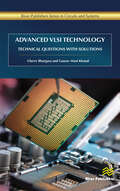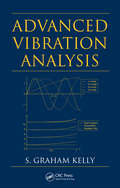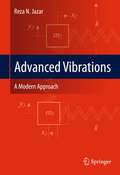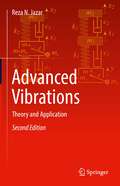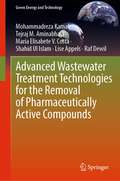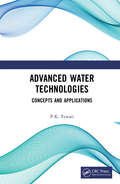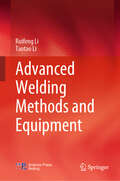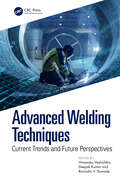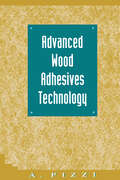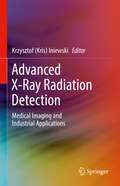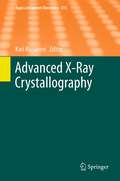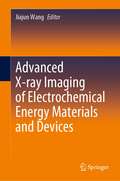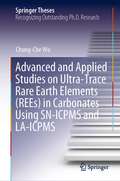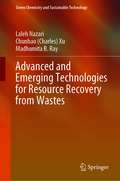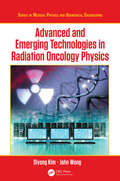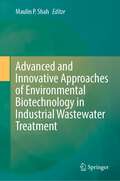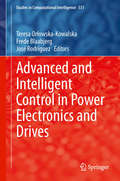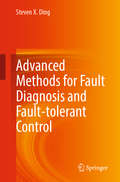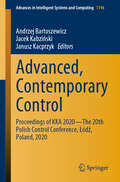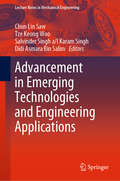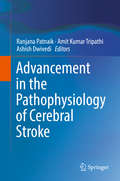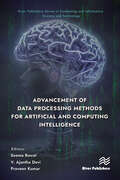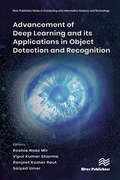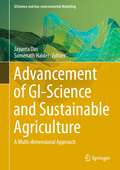- Table View
- List View
Advanced VLSI Technology: Technical Questions with Solutions
by Cherry Bhargava Gaurav Mani KhanalThe trend in design and manufacturing of very large-scale integrated (VLSI) circuits is towards smaller devices on increasing wafer dimensions. VLSI is the inter-disciplinary science of the process of creating an integrated circuit (IC) by combining thousands of transistors into a single chip. VLSI design can reduce the area of the circuit, making it less expensive and requiring less power.The book gives an understanding of the underlying principles of the subject. It not only focuses on circuit design process obeying VLSI rules but also on technological aspects of prototyping and fabrication. All the clocking processes, interconnects, and circuits of CMOS are explained in this book in an understandable format. The book provides contents on VLSI Physical Design Automation, Design of VLSI Devices and also its Impact on Physical Design.The book is intended as a reference book for senior undergraduate, first-year post graduate students, researchers as well as academicians in VLSI design, electronics & electrical engineering, and materials science. The basics and applications of VLSI design from STA, PDA and VLSI Testing along with FPGA based Prototyping are covered in a comprehensive manner.The latest technology used in VLSI design is discussed along with the available tools for FPGA prototyping as well as ASIC design. Each unit contains technical questions with solutions at the end.Technical topics discussed in the book include: • Static Timing Analysis• CMOS Layout and Design rules• Physical Design Automation• Testing of VLSI Circuits• Software tools for Frontend and Backend design.
Advanced Vibration Analysis
by S. Graham KellyDelineating a comprehensive theory, Advanced Vibration Analysis provides the bedrock for building a general mathematical framework for the analysis of a model of a physical system undergoing vibration. The book illustrates how the physics of a problem is used to develop a more specific framework for the analysis of that problem. The author elucidat
Advanced Vibrations: A Modern Approach
by Reza N. JazarAdvanced Vibrations: A Modern Approach is presented at a theoretical-practical level and explains mechanical vibrations concepts in detail, concentrating on their practical use. Related theorems and formal proofs are provided, as are real-life applications. Students, researchers and practicing engineers alike will appreciate the user-friendly presentation of a wealth of topics including but not limited to practical optimization for designing vibration isolators, and transient, harmonic and random excitations.
Advanced Vibrations: Theory and Application
by Reza N. JazarNow in an updated new edition, this textbook explains mechanical vibrations concepts in detail, concentrating on their practical use. This second edition includes the new chapter Multi-Degree-of-Freedom (MDOF) Time Response, as well as new sections covering superposition, music and vibrations, generalized coordinates and degrees-of-freedom, and first-order systems. Related theorems and formal proofs are provided, as are real-life applications. Students, researchers, and practicing engineers alike will appreciate the user-friendly presentation of a wealth of topics, including practical optimization for designing vibration isolators and transient and harmonic excitations. Advanced Vibrations: Theory and Application is an ideal text for students of engineering, designers, and practicing engineers.
Advanced Wastewater Treatment Technologies for the Removal of Pharmaceutically Active Compounds (Green Energy and Technology)
by Mohammadreza Kamali Tejraj M. Aminabhavi Lise Appels Raf Dewil Maria Elisabete V. Costa Shahid Ul IslamThis book reports on the treatment of waters and wastewaters with contaminants of emerging concern such as pharmaceutically active compounds. It shows how to prevent the contamination of the environment with such pollutants in the content of effluents. This book reviews various physico-chemical and biological methods that have been developed in order to deal with the polluted effluents. It also evaluates the already developed technologies regarding the sustainability criteria. The chapters discuss technical aspects and put the spotlight on the sustainability aspects of the water and wastewater treatment technologies.
Advanced Water Technologies: Concepts and Applications
by P.K. TewariThe book explores basic concepts and advanced topics in the field of water technologies. It deals extensively with advances in materials, material selection, preparation, characterization and application. The relevance of water technologies in industries is considered, and a section is dedicated to describing and analyzing the technologies required for water reuse and advanced purification, including desalination. Nuclear desalination, low-carbon desalination and water purification technologies to address the adverse impacts of climate change are examined from both the adaptation and mitigation points of view. Aimed at senior undergraduate/graduate students in chemical, civil and environmental engineering, along with wastewater and desalination researchers, this book: Details advanced water treatments for varied processes. Describes membrane and desalination techniques for water reuse and advanced purification. Elaborates water technologies at both the front and back ends of the process. Discusses modern technologies for effluent treatment and water recycling. Explores the role of information technology in the water sector.
Advanced Welding Methods and Equipment
by Ruifeng Li Taotao LiThis book helps graduate students master welding theory, advanced welding technology and welding practice. With the continuous development and deepening of welding technology and the rapid development of computer science, the content of "Advanced Welding Methods" has also been expanded. It is divided into seven chapters, including laser welding, electron beam welding, friction stir welding, narrow gap welding, laser-arc hybrid welding, underwater welding, and development of the traditional welding process. The compilation of this book combines theory and practice, focusing not only on teaching and training theoretical knowledge, but also on integrating cases and providing practical training. Advanced Welding Methods and Equipment is a highly theoretical and practical course, which is an important link to improve students' welding practice ability and innovation ability. It is of great help for students to learn and understand welding technology. This book is used as a textbook for graduate students of related majors, and also as a reference for welding technology developers and researchers of related colleges and universities.
Advanced Welding Techniques: Current Trends and Future Perspectives
by Deepak Kumar Himanshu Vashishtha Ravindra V TaiwadeTo meet weight, quality, and cost targets, it is essential to design, develop, and manufacture optimal, cost- effective welded structures that take into consideration material, process, and dimensioning procedures. For effective design, a weld designer must have a comprehensive grasp of welding basics, associated metallurgy, and fabrication and characterization processes. Advanced Welding Techniques highlights breakthroughs in advances in welding methods and provides readers with the ability to accurately identify the appropriate welding processes and optimal improvement methods for intended applications. It offers comprehensive guidance on welding design to ensure readers are equipped to provide solutions to any technical malfunctions they may encounter, including: Supplies essential stepwise knowledge on design for welding, starting with the fundamentals to the complex Covers role of filler metals and parameters on welding performance, emerging and advanced welding techniques, and advantages and limitations of various methods Discusses integration of additive manufacturing and welding Contains practical applications Considers challenges and future scope for further research as well as future challenges This book offers students, academics, researchers, scientists, engineers, and industry experts a comprehensive overview of the most recent breakthroughs in advanced welding methods and their applications to joining various metals and their alloys.
Advanced Welding Techniques: Holistic View with Design Perspectives
by Mukti Chaturvedi S. Arungalai VendanThis book provides an insight into the welding techniques with a cross-disciplinary treatment to address the shortcomings of contemporary learning of welding terminology. Various topics covered include introduction to welding processes, design requirements, prominence of design, case studies presenting structural defacements due to inappropriate design, comprehensive surveys on welding processes selected from various process categories, design calculations to be adopted for specific applications and sample calculations. This book is useful for researchers, engineers and professionals working on welding equipment and technologies.
Advanced Wood Adhesives Technology
by A. PizziThis work discusses the latest innovations in the manufacture of wood adhesives, and shows how to test their composition. Methods of varying parameters to obtain particular effects are explained, and background summaries of each class of adhesives are provided.
Advanced X-Ray Radiation Detection: Medical Imaging and Industrial Applications
by Krzysztof Kris IniewskiThis book offers readers an overview of some of the most recent advances in the field of technology for X-ray medical imaging. Coverage includes both technology and applications in SPECT, PET and CT, with an in-depth review of the research topics from leading specialists in the field. Coverage includes conversion of the X-ray signal into analogue/digital value, as well as a review of CMOS chips for X-ray image sensors. Emphasis is on high-Z materials like CdTe, CZT and GaAs, since they offer the best implementation possibilities for direct conversion X-ray detectors. The discussion includes material challenges, detector operation physics and technology and readout integrated circuits required to detect signals processes by high-Z sensors. Authors contrast these emerging technologies with more established ones based on scintillator materials. This book is an excellent reference for people already working in the field as well as for people wishing to enter it.
Advanced X-ray Crystallography (Topics in Current Chemistry #315)
by Kari RissanenComputational Studies of Crystal Structure and Bonding, by Angelo Gavezzotti Cryo-Crystallography: Diffraction at Low Temperature and More, by Piero Macchi High-Pressure Crystallography, by Malcolm I. McMahon Chemical X-Ray Photodiffraction: Principles, Examples, and Perspectives, by Panče Naumov Powder Diffraction Crystallography of Molecular Solids, by Kenneth D. M. Harris
Advanced X-ray Imaging of Electrochemical Energy Materials and Devices
by Jiajun WangThis book comprehensively outlines synchrotron-based X-ray imaging technologies and their associated applications in gaining fundamental insights into the physical and chemical properties as well as reaction mechanisms of energy materials. In this book the major X-ray imaging technologies utilised, depending on research goals and sample specifications, are discussed. With X-ray imaging techniques, the morphology, phase, lattice and strain information of energy materials in both 2D and 3D can be obtained in an intuitive way. In addition, due to the high penetration of X-rays, operando/in situ experiments can be designed to track the qualitative and quantitative changes of the samples during operation. This book will broader the reader’s view on X-ray imaging techniques and inspire new ideas and possibilities in energy materials research.
Advanced and Applied Studies on Ultra-Trace Rare Earth Elements (Springer Theses)
by Chung-Che WuThis book provides two state-of-the-art quantitative techniques to determine ultra-trace rare earth elements (REEs) in natural carbonates using solution nebulization-inductively coupled plasma mass spectrometry (SN-ICPMS) and laser ablation-inductively coupled plasma mass spectrometry (LA-ICPMS) with respective applications were presented in this dissertation. These techniques were applied to natural carbonates, including corals and stalagmites, to understand volcano eruptions and the impacts on modern biosystem and paleoclimate regimes. In the first SN-ICPMS protocol, direct measurements for femtogram quantity carbonate samples without chemical separation steps can offer accurate and high-precision analysis (±1.9-6.5%, 2σ) with a high sample throughput of 8-10 samples/hr routinely. Application to modern Porites corals collected from South China Sea region, the anomalies of REE contents and Al/Ca ratios associated with micro-domain images, register modern coral reefs could be exacerbated by volcanic eruptions. In the second protocol, a high-sensitivity quantitative open-cell LA-ICPMS technique has been established to allow direct sampling on stalagmite surface in the atmospheric air. This technique improved limits of detection down to sub-ng/g range and promises analyses of carbonate REE profiles at the single digit parts-per-billion (ppb) levels. Application to a 15-cm stalagmite collected from East Timor reveals two peaks of REE contents by at least one order of magnitude, possibly due to volcanic ash preserved in stalagmite. Both improved SN-ICPMS and LA-ICPMS techniques highlight the high-sensitivity and high-temporal-resolution carbonate REE analyses for corals and stalagmites, with great potential to other natural carbonates such as travertine, tufa, and flowstone, benefit our understanding of paleoclimatic and paleoenvironmental dynamics.
Advanced and Emerging Technologies for Resource Recovery from Wastes (Green Chemistry and Sustainable Technology)
by Chunbao (Charles) Xu Laleh Nazari Madhumita B. RayThis book introduces advanced or emerging technologies for conversion of wastes into a variety of high-value chemicals and materials. Energy and resources can be recovered from various residential, industrial and commercial wastes, such as municipal wastewater and sludge, e-waste, waste plastics and resins, crop residues, forestry residues and lignin. Advanced waste-to-resource and energy technologies like pyrolysis, hydrothermal liquefaction, fractionation, de-polymerization, gasification and carbonization are also introduced. The book serves as an essential guide to dealing with various types of wastes and the methods of disposal, recovery, recycling and re-use. As such it is a valuable resource for a wide readership, including graduate students, academic researchers, industrial researchers and practitioners in chemical engineering, waste management, waste to energy and resources conversion and biorefinery.
Advanced and Emerging Technologies in Radiation Oncology Physics (Series in Medical Physics and Biomedical Engineering)
by Siyong Kim John W. WongThis new book educates readers about new technologies before they appear in hospitals, enabling medical physicists and clinicians to prepare for new technologies thoroughly and proactively, and provide better patient care once new equipment becomes available. Emerging technologies in imaging, treatment planning, treatment delivery, dosimetry and informatics are all discussed. The book is divided into three parts: recently developed technologies available for practice; technologies under development nearing completion; and technologies in an early stage of development that could have potential radiotherapy applications. Features: Introduces emerging technologies in imaging, treatment planning, treatment delivery, dosimetry and informatics The advantages and limitations of each technology in clinical settings are discussed, and recommendations on how to adopt the technologies are provided Critiques and improvement points are provided for researchers, in addition to suggestions on how to prepare quality assurance are provided as needed
Advanced and Innovative Approaches of Environmental Biotechnology in Industrial Wastewater Treatment
by Maulin P. ShahThis book discusses new and innovative trends and techniques in the removal of toxic and refractory pollutants by means of various microbial biotechnology processes from wastewater, both on the laboratory and industrial scales. The book also highlights the main factors contributing to the removal of toxic pollutants as well as recycling, environmental impact, and wastewater policies after heavy metal removal. In addition, it assesses the potential application of several existing bioremediation techniques and introduces new cutting-edge emerging technologies. This book significantly contributes to the wastewater treatment plant industry so that the treatment systems can serve better and more resiliently for the purpose. This book is designed for engineers, scientists, and other professionals who are seeking introductory knowledge of the principles of environmental bioremediation technology and for students who are interested in the environmental microbiology and bioremediation fields.
Advanced and Intelligent Control in Power Electronics and Drives (Studies in Computational Intelligence #531)
by José Rodríguez Frede Blaabjerg Teresa Orłowska-KowalskaPower electronics and variable frequency drives are continuously developing multidisciplinary fields in electrical engineering and it is practically not possible to write a book covering the entire area by one individual specialist. Especially by taking account the recent fast development in the neighboring fields like control theory, computational intelligence and signal processing, which all strongly influence new solutions in control of power electronics and drives. Therefore, this book is written by individual key specialist working on the area of modern advanced control methods which penetrates current implementation of power converters and drives. Although some of the presented methods are still not adopted by industry, they create new solutions with high further research and application potential. The material of the book is presented in the following three parts: Part I: Advanced Power Electronic Control in Renewable Energy Sources (Chapters 1-4), Part II: Predictive Control of Power Converters and Drives (5-7), Part III: Neurocontrol and Nonlinear Control of Power Converters and Drives (8-11). The book is intended for engineers, researchers and students in the field of power electronics and drives who are interested in the use of advanced control methods and also for specialists from the control theory area who like to explore new area of applications.
Advanced methods for fault diagnosis and fault-tolerant control
by Steven X. DingThe major objective of this book is to introduce advanced design and (online) optimization methods for fault diagnosis and fault-tolerant control from different aspects. Under the aspect of system types, fault diagnosis and fault-tolerant issues are dealt with for linear time-invariant and time-varying systems as well as for nonlinear and distributed (including networked) systems. From the methodological point of view, both model-based and data-driven schemes are investigated.To allow for a self-contained study and enable an easy implementation in real applications, the necessary knowledge as well as tools in mathematics and control theory are included in this book. The main results with the fault diagnosis and fault-tolerant schemes are presented in form of algorithms and demonstrated by means of benchmark case studies. The intended audience of this book are process and control engineers, engineering students and researchers with control engineering background.
Advanced, Contemporary Control: Proceedings of KKA 2020—The 20th Polish Control Conference, Łódź, Poland, 2020 (Advances in Intelligent Systems and Computing #1196)
by Andrzej Bartoszewicz Janusz Kacprzyk Jacek KabzińskiThis book presents the proceedings of the 20th Polish Control Conference. A triennial event that was first held in 1958, the conference successfully combines its long tradition with a modern approach to shed light on problems in control engineering, automation, robotics and a wide range of applications in these disciplines. The book presents new theoretical results concerning the steering of dynamical systems, as well as industrial case studies and worked solutions to real-world problems in contemporary engineering. It particularly focuses on the modelling, identification, analysis and design of automation systems; however, it also addresses the evaluation of their performance, efficiency and reliability. Other topics include fault-tolerant control in robotics, automated manufacturing, mechatronics and industrial systems. Moreover, it discusses data processing and transfer issues, covering a variety of methodologies, including model predictive, robust and adaptive techniques, as well as algebraic and geometric methods, and fractional order calculus approaches. The book also examines essential application areas, such as transportation and autonomous intelligent vehicle systems, robotic arms, mobile manipulators, cyber-physical systems, electric drives and both surface and underwater marine vessels. Lastly, it explores biological and medical applications of the control-theory-inspired methods.
Advancement in Emerging Technologies and Engineering Applications (Lecture Notes in Mechanical Engineering)
by Chun Lin Saw Tze Keong Woo Salvinder Singh a/l Karam Singh Didi Asmara Bin SalimThis volume contains selected and reviewed manuscripts from the 2nd Regional Conference on Mechanical and Marine Engineering (ReMME 2018), ‘Sustainable Through Engineering,’ which was held from November 7 to 9, 2018, at the Ipoh, Perak, Malaysia. This conference was organized by the Center of Refrigeration and Air Conditioning (CARe) and Center of Marine Engineering (CTME) Politeknik Ungku Omar, Jalan Raja Musa Mahadi, 31400 Ipoh, Perak. It discusses the expertise, skills, and techniques needed for the development of energy and renewable energy system, new materials and biomaterials, and marine technology. It focuses on finite element analysis, computational fluids dynamics, programming and mathematical methods that are used for engineering simulations, and present many state-of-the-art applications. For example, modern joining technologies can be used to fabricate new compound or composite materials, even those formed from dissimilar component materials. These composite materials are often exposed to harsh environments, must deliver specific characteristics, and are primarily used in automotive and marine technologies, i.e., ships, amphibious vehicles, docks, offshore structures, and even robots. An energy efficient methods such cogeneration, thermal energy storage and solar desalination also being highlighted as sustainable engineering in this book chapter. The committee members can be listed as follows: Patron:Dr. Hj. Zairon Mustapha (Director). Advisor: Muhmmad Zubir Mohd Hanifah (Deputy Director Academic), Dr. Azhar Abdullah (Head of Innovation, Research & Commercialization). Chairman 1: Dr. Adzuieen Nordin. Chairman 2: Hairi Haizri Che Amat. Secretariat 1: Dr. Woo Tze Keong. Secretariat 2: Dr. Saw Chun Lin. Secretary: Mahani Mohd Zamberi, Maslinda Rahmad. Floor Manager: Dr. Adzuieen Nordin, Marzuki Mohammad Treasurer: Shahrul Nahar Omar Kamal. Webmaster: Mohamad Asyraf Othoman, Mohd Assidiq Che Ahmad, Mohd Hashim Abd. Razak. Proceeding & Editorial: Didi Asmara Salim, Khairil Ashraf Ahmad Maliki, Khirwizam Md Hkhir. Publicity: Nur Azrina Zainal Ariff, Norsheila Buyamin, Rawaida Muhammad, Noor Khairunnisa Kamaruddin. Reviewer: Zakiman Zali, Shahril Jalil. Technical Manager: Mohd Faisol Saad. Springer Publication Editorial: Dr. Saw Chun Lin, Dr. Woo Tze Keong, Didi Asmara Salim, Dr. Salvinder Singh Karam Singh. Protocol & Opening Ceremony: Mohd Rizan Abdul, Yeoh Poh See. Souvenir: Sharifah Zainhuda Syed Tajul Ariffin. Registration: Muhammad Zaki Zainal, Adi Firdaus Hat, Nor Ashimy Mohd Noor, Mohd Naim Awang. Proofread: Shamsul Banu Mohamed Siddik, Fairuz Liza Shuhaimi. Logistics: Mohd Zulhairi Zulkipli, Ahmad Fithri Hasyimie Hashim. Multimedia: Muhammad Redzuan Che Noordin, Mohd Redzuwan Danuri, Ahmad Syawal Yeop Aziz. Liason: Roseazah Ramli, Amrul Zani Mahadi. Sponsorship: Zuraini Gani, Hazril Hisham Hussin.
Advancement in the Pathophysiology of Cerebral Stroke
by Ashish Dwivedi Ranjana Patnaik Amit Kumar TripathiThis book provides detailed and comprehensive mechanistic insights of the various risk factors that lead to the ischemic stroke and the novel therapeutic interventions against it. The first section discusses the different ischemic cerebral stroke-induced inflammatory pathways and dysfunctionality of blood-brain barrier. The later sections of the book deals with the role of endoplasmic reticulum stress and mitophagy in cerebral stroke and introduces the different neuroimaging techniques such as Computed tomography (CT), Magnetic resonance imaging (MRI), Positron emission tomography (PET) and Single-Photon emission computed tomography (SPECT) that are used to identify the arterial blockages. The final section comprises of chapters that focus on various neuroprotective strategies and emerging therapeutic interventions for combating stroke pathophysiology. The chapters cover the role of stem cell therapy, the therapeutic effect of low-frequency electromagnetic radiations (LF-EMR), and implications of non-coding RNAs such as micro-RNAs as the biomarkers for diagnosis, prognosis, and therapy in ischemic stroke.
Advancement of Data Processing Methods for Artificial and Computing Intelligence (River Publishers Series in Computing and Information Science and Technology)
by Praveen Kumar V. Ajantha Devi Seema RawatThis book emphasizes the applications of advances in data processing methods for Artificial Intelligence in today's fast-changing world, as well as to serve society through research, innovation, and development in this field. This book is applicable to a wide range of data that contribute to data science concerns and can be used to promote research in this high-potential new field. People's perceptions of the world and how they conduct their lives have changed dramatically as a result of technological advancements. The world has been gripped by technology, and the advances that are being made every day are undeniably transforming the planet. In the domains of Big Data, engineering, and data science, this cutting-edge technology is ready to support us.Artificial intelligence (AI) is a current research topic because it can be applied to a wide range of applications and disciplines to solve complicated problems and find optimal solutions. In research, medicine, technology, and the social sciences, the benefits of AI have already been proven. Data science, also known as pattern analytics and mining, is a technique for extracting useful and relevant information from databases, enabling better decision-making and strategy formulation in a range of fields. As a result of the exponential growth of data in recent years, the combined notions of big data and AI have given rise to many study areas, such as scale-up behaviour from classical algorithms. Furthermore, combining numerous AI technologies from other areas (such as vision, security, control, and biology) in order to build efficient and durable systems that interact in the real world is a new problem. Despite recent improvements in fundamental AI technologies, the integration of these skills into larger, trustworthy, transparent, and maintainable systems is still in its development. Both conceptually and practically, there are a number of unanswered issues.
Advancement of Deep Learning and its Applications in Object Detection and Recognition
by Ranjeet Kumar Rout Saiyed Umer Roohie Naaz Mir Vipul Kumar SharmaObject detection is a basic visual identification problem in computer vision that has been explored extensively over the years. Visual object detection seeks to discover objects of specific target classes in a given image with pinpoint accuracy and apply a class label to each object instance. Object recognition strategies based on deep learning have been intensively investigated in recent years as a result of the remarkable success of deep learning-based image categorization. In this book, we go through in detail detector architectures, feature learning, proposal generation, sampling strategies, and other issues that affect detection performance. The book describes every newly proposed novel solution but skips through the fundamentals so that readers can see the field's cutting edge more rapidly. Moreover, unlike prior object detection publications, this project analyses deep learning-based object identification methods systematically and exhaustively, and also gives the most recent detection solutions and a collection of noteworthy research trends. The book focuses primarily on step-by-step discussion, an extensive literature review, detailed analysis and discussion, and rigorous experimentation results. Furthermore, a practical approach is displayed and encouraged.
Advancement of GI-Science and Sustainable Agriculture: A Multi-dimensional Approach (GIScience and Geo-environmental Modelling)
by Jayanta Das Somenath HalderThis book describes the contributing aspects of contemporary developments related to sustainable agricultural resources and assessment of sustainable agriculture in developing nations. The issues like food crisis and declining agro-productivity, post-pandemic food security, zonation and mapping technique viewing food crisis, biotechnology and sustainable agricultural, scaling hunger indices, health hazard and food crisis, changing climate and food availability, consumer load and fertilizer usage, growing demand and increasing usage of harmful chemical in agro-fields are regarded as serious concerns. Thereafter, the scope of sustainable agricultural potentiality (SAP) modeling, amidst the arena of deforestation and encroachment of new cultivable land, impact of pandemic on sustainable agriculture, using wastewater as non-sustainable agricultural practice, applying geospatial techniques on extreme weather susceptibility and agro-production, soil erosion and poor agricultural production, questioning shifting cultivation on the issue of sustainability, meteorological drought and irrigational gaps, occupational mobility and loss of agricultural heritage, farm-excreta burning and air quality index (AQI), GI-Science and sustainable agro-management, community preparedness in food crisis management, multi-criteria hunger index (MCHI), climate change declining sustainable agro-production are worth some. Almost the entire world has recently suffered from several natural and human-induced problems, among which food crisis and unsustainable agriculture throw significant challenges to human society. Contrastingly, if modern technology and means, with advanced monitoring and calibration methodology and policy guidance, can help, it will undoubtedly reduce half of the world's problems and ensure the future survival of human society. In addition, this approach also can minimize the other partially linked problems, like climate change and food shortage, livelihood crisis, environmental refugees, international trade balance, global food supply chain interruption, the ever-expanding gap between rich and poor, and so on. Therefore, properly nurturing the knowledge on the application of GI-Science for an agriculturally sustainable society and their monitoring and management can curtail the gap between science, policy, and the ground-level scenario concerned.
